
* Late in World War II, the Douglas aircraft company developed a new piston-powered carrier-based attack aircraft for the US Navy, which emerged as the "AD Skyraider". The Skyraider was built in good numbers, not only for the attack role but for the electronic countermeasures, airborne early warning, and other roles. The AD was a rugged and powerful aircraft that proved its worth in Korea and Vietnam in the hands of Navy, Marine, and Air Force pilots. It also saw service with a number of foreign air arms. This document provides a history and description of the Skyraider. A list of illustration credits is included at the end.
* The Douglas SBD Dauntless dive-bomber had a remarkably successful combat career during World War II with the US Navy and Marine Corps, but even at the time it was clearly a somewhat antiquated design. The Curtiss SB2C Helldiver was supposed to have replaced it, but the Helldiver was one of the most despised US Navy aircraft of the conflict, and flight crews tended to prefer their reliable, if outdated, Dauntlesses.
The Navy awarded a contract to Douglas to provide a more adequate replacement for the Dauntless, in the form of the big "XSB2D-1 Destroyer" two-seat scout bomber. The XSB2D-1 was powered by a Wright R-3350-14 air-cooled radial engine providing 1,715 kW (2,300 HP), and featured an inverted gull wing plus tricycle landing gear -- the last being an unusual feature for carrier aircraft at the time. It was to carry heavy defensive armament, with remote-controlled turrets top and bottom on the rear fuselage. Initial flight of the prototype was on 8 April 1943.
Douglas also worked on a larger three-seat torpedo bomber along the same lines, the "XTB2D-1 Skypirate", with two prototypes built, the first flying on 13 March 1945. However, the Navy had been having second thoughts, with the result that the service decided they needed a single-seat aircraft to fulfill both the dive-bomber and torpedo-bomber roles and that defensive turrets were not needed. Douglas filed away the design for the Skypirate and redesigned the Destroyer into the "XBTD-1", converting it to a single-seat configuration, eliminating the turrets, adding a 20-millimeter cannon to each wing, expanding the internal bomb bay to accommodate a torpedo, and increasing the fuel capacity. Initial flight of the XBTD-1 prototype was on 5 March 1944.
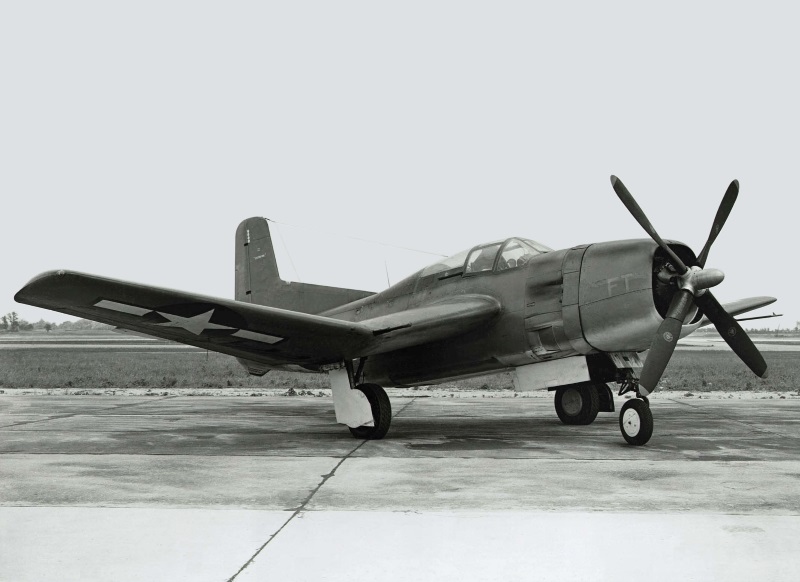
The precise fate of the TBD program is unclear, with different sources giving different reads on the story. Some sources claim the program was canceled in July 1944 with no production machines built, others more plausibly claim that 28 BTD-1 production aircraft were built up to the end of the war; two of were fitted with an auxiliary Westinghouse 19B turbojet in the rear fuselage, providing 6.7 kN (680 kgp / 1,500 lbf) thrust, and designated "XTBD-2". Whatever the case, the program was abandoned and the BTD-1 never saw operational service. Sources are also mixed on the virtues of the type. One survives as a museum piece.
* Clearly, one of the contributing factors to the truncated life of the BTD-1 was the fact that the Navy wanted a more optimized single-seat scout / torpedo bomber. Four manufacturers submitted proposals during 1944: Curtiss offered the "XBTC-1", Douglas offered the "XBT2D-1", Kaiser-Fleetwings the "XBTK-1", and Martin the "XBTM-1". Some sources also claim the monster Boeing "XF8B-1" was submitted for the requirement, but it was actually designed as a long-range fighter; possibly Boeing suggested that it could be adapted to the scout / torpedo role.
All these machines had a roughly comparable configuration, being low-winged aircraft with taildragger landing gear and a radial engine. The Douglas and Martin proposals were approved for production, though only a relatively small batch of the Martin design, with the service designation of "AM-1 Mauler", was built in the immediate postwar period, sources giving the number of aircraft rolled out as 149. They served into the early 1950s, generally in the reserve role.
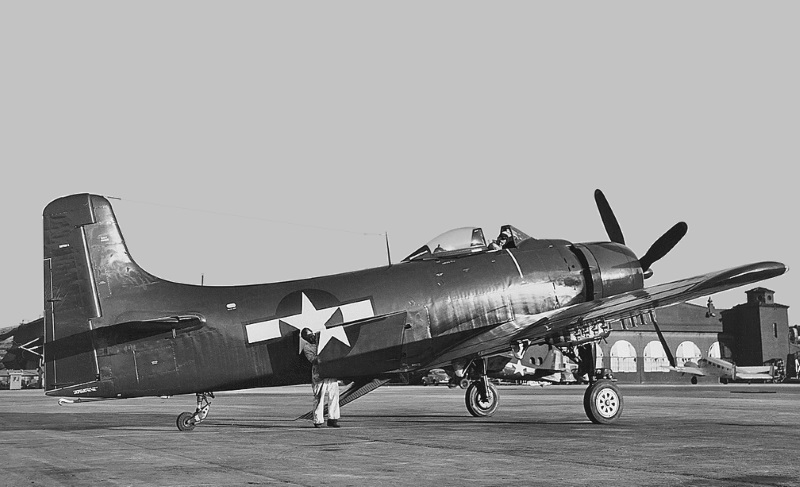
The Douglas design ended up being preferred. Initial flight of the first of 25 prototype / evaluation "XBT2D-1 Dauntless II" aircraft was on 18 March 1945, with test pilot Laverne Brown at the controls. Initial production contracts followed only weeks later. While the XBT2D-1 couldn't carry the warload that the Mauler could, it was more reliable, easier to fly, and easier to handle on the carrier deck. It was also designed for flexibility, with a range of variants for different roles planned. Of the 25 prototypes:
The 25th prototype was used to evaluate an improved attack variant, as discussed below. All these configurations reached production, also as discussed below, except for the XBT2D-1P; no dedicated photo-reconnaissance variant ever reached service.
In 1946, the Navy changed the name of the XBT2D-1, with the production version becoming the "AD-1 Skyraider", with "AD" standing for "Attack / Douglas". The first AD-1 performed its initial flight on 5 November 1946, and went into formal service in 1947. 242 AD-1s were built into 1949. In service, aircrew called it the "Able Dog" after its designation; it would eventually be better known as the "Spad", it appears as an outgrowth of "AD".
BACK_TO_TOP* The AD-1 provides a useful baseline for the Skyraider family. The AD-1 was the product of a design team under the well-known Ed Heinemann, along with Leo Devlin and Gene Root. It was of generally straightforward configuration, of all-metal construction -- mostly aircraft aluminum, with a low-mounted wing and a conventional tail arrangement. Somewhat unusually for the postwar period, it featured taildragger landing gear, all gear assemblies with single wheels and retractable, with each main gear assembly backwards into the wing, and the wheel folding 90 degrees to lie flat. There was a stinger-style arresting hook behind the tailwheel.
The AD-1 was powered by a Wright R-3350-24W Duplex Cyclone two-row air-cooled eighteen-cylinder engine with water-methanol injection and 1,865 kW (2,500 HP), fitted with a single-stage / two-speed supercharger and driving a four-bladed Aeroproducts hydraulically-actuated constant-speed propeller, with a diameter of 4.12 meters (13 feet 6 inches). The engine was mounted tilted down 4.5 degrees from the centerline, reducing the effect of trim changes. The AD-1's appearance, which could only be called "functional" at the most charitable, was further cluttered by an airscoop for the carburetor and for cockpit ventilation behind the engine on top, and another airscoop on the bottom, for an oil cooler. There was only one internal fuel tank, presumably self-sealing, placed behind the cockpit and with a capacity of 1,325 liters (350 US gallons).

The wings had a dihedral of 6 degrees, and an incidence of 4 degrees. They folded up hydraulically near mid-span. The tail assembly, as mentioned, was of conventional layout, with a flat tailplane -- no dihedral or anhedral. The control surface arrangement was conventional as well, with a large flap on each inboard wing section, a large aileron running the full span of the outer wing section, plus elevators and a rudder. There were very large hydraulically-operated dive brakes on each side of the fuselage, and on the belly behind the wings.
Built-in armament consisted of a single M3 20-millimeter cannon in each wing just inboard of the wing fold or two cannons in total, with a maximum of 200 rounds per cannon. As far as external warload went, there was a centerline stores pylon, a single pylon under each inner wing, and six pylons on each outer wing -- for a total of 15 pylons. The centerline pylon could carry a store with a weight of up to 1,630 kilograms (3,600 pounds), while each inboard pylon could handle up to 1,360 kilograms (3,000 pounds), and each outboard pylon could handle up to 225 kilograms (500 pounds). However, the total warload on the outboard pylons for each wing could not exceed 1,135 kilograms (2,500 pounds), and since the outboard pylons were tightly spaced, clearance issues also led to limitations on stores configurations.
The centerline and inboard pylons were "wet" and could be used to carry external fuel tanks, it seems typically one 568-liter (150 US gallon) tank on the centerline or two 1,140-liter (300 US gallon) tanks on the inboard pylons. The outboard stores pylons were intended for carrying smaller munitions like the 127-millimeter (5-inch) "high velocity aircraft rocket (HVAR)" or 115-kilogram (250-pound) bomb.
Total external warload is given in many sources as a whopping 3,630 kilograms (8,000 pounds); however, that appears to have been the effective limit, not practical for carrier operations, and not a particularly sane configuration -- though there were cases where Skyraiders were loaded up well in excess of that weight. Few photos of "bombed up" Skyraiders show them that overburdened, with pictures of heavily laden machines showing them hauling, for example, twelve 115-kilogram and three 225-kilogram bombs, giving a generous total warload of about 2,050 kilograms (4,500 pounds).
Another heavy-load configuration was twelve HVARs, at about 65 kilograms (150 pounds) each, and three 450-kilogram (1,000-pound) bombs, for a total warload of about 2,130 kilograms (4,800 pounds). A realistic external warload limit was probably more like 2,720 kilograms (6,000 pounds). Along with bombs and HVARs, Skyraiders could carry napalm tanks, the "Tiny Tim" unguided rocket (along the lines of a giant HVAR, with a diameter of 30 centimeters / a foot), and air-dropped torpedoes. It doesn't appear from photos that Skyraiders often carried Tiny Tims or torpedoes in service -- though there was a case in the Korean War where torpedoes were used to destroy a dam.
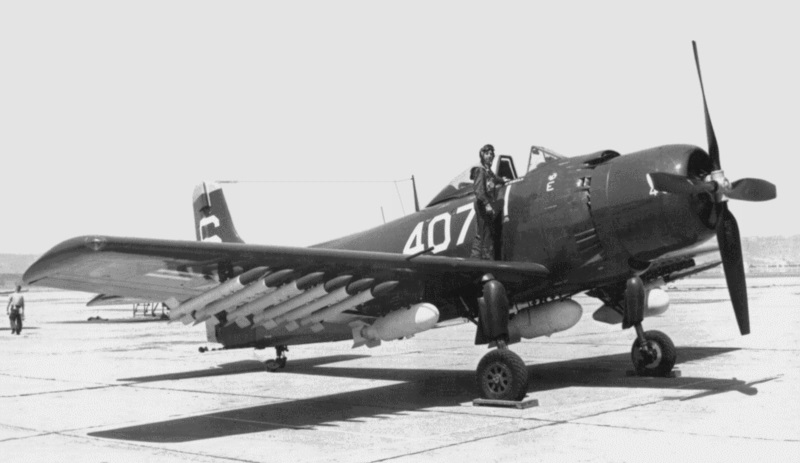
The pilot sat under a bubble-type canopy that slid back to open. Field of view was said to be excellent. The pilot was protected by cockpit armor, but there was no ejection seat; clearing the big tail was a problem when bailing out. Avionics were simple, including a radio, identification friend or foe (IFF) unit, and radio navigation aids; the pilot used a deflection gunsight for targeting weapons delivery. Although the prototypes had generally been flown in natural metal colors, in service Skyraiders were typically painted overall dark blue, the Navy standard colors of the era.
___________________________________________________________________
DOUGLAS AD-1 SKYRAIDER:
___________________________________________________________________
wingspan:
15.24 meters (50 feet)
wing area:
37.21 sq_meters (400.33 sq_feet)
length:
11.64 meters (38 feet 2 inches)
height:
3.66 meters (12 feet)
empty weight:
4,760 kilograms (10,500 pounds)
normal loaded weight:
6,305 kilograms (13,900 pounds)
MTO weight:
8,165 kilograms (18,000 pounds)
max speed at altitude:
590 KPH (365 MPH / 315 KT)
service ceiling:
7,925 meters (26,000 feet)
range:
2,500 kilometers (1,550 MI / 1,350 NMI)
___________________________________________________________________
The AD-1 was generally similar to the XBT2D-1 attack prototypes, though the first four XBT2D-1 prototypes were powered with the Wright R-3350-8 with 1,715 kW (2,300 HP), not the R-3350-24W; the prototypes also had some small detail differences from the AD-1 -- for example, their landing gear and wing skinning had also proven not robust enough, demanding strengthening.
* Along with the 242 AD-1 Skyraiders, a total of 35 "AD-1Q" ECM machines was built, based on the XBT2D-1Q. They accommodated an ECM operator in a cozy compartment in the fuselage behind the pilot's cockpit; there was a door with a window on the right side of the fuselage and a window on the left side of the fuselage. It looked like it might have been difficult to get out of the compartment in a hurry. A jammer pod was carried under the right wing, while a chaff dispenser was carried under the left wing. A suite of other ECM gear was carried internally, manifested by additional antennas, a small fairing on each side of the rear fuselage, and an airscoop to cool the ECM gear mounted on the aircraft's back between the cockpit and tailfin.
BACK_TO_TOP* In service, the AD-1 demonstrated that not all the bugs had been worked out of the Skyraider design, and some revisions were required. As noted, one of the 25 XBT2D-1 prototypes had been set aside for evaluating such improvements, with this machine emerging as the "XAD-2". The major changes were airframe strengthening; fit of the R-3350-26W engine, providing 2,250 kW (3,020 HP); and internal fuel capacity raised to 1,440 liters (380 US gallons). Doors were added for the main landing gear, plus tweaks to the engine installation and to the cockpit arrangement as well. Some sources claim the AD-2 introduced external tank carriage -- but that's puzzling, since pictures of AD-1s show them with external tanks, and it is hard to understand why the AD-1 wouldn't have been built with that capability.
Following conversion of an AD-1 to an AD-2 preproduction prototype, initial service deliveries began in 1948, with 156 AD-2s built in all. Two AD-2s were later converted to "AD-2D" drone director aircraft, carrying a radio link and an operator to remotely pilot a robot aircraft -- some sources claim these machines were actually drones, however. An ECM version, the "AD-2Q", an updated AD-1Q, was produced as well, with 22 built. One was eventually converted into a target tow tug and redesignated "AD-2QU".

* The AD-2 was quickly followed in production by the "AD-3" -- incidentally, that designation was originally given to a dead-end turboprop version of the Skyraider, the "Skyshark", discussed below, but the Skyshark ended up different enough to warrant its own type designation of "A2D-1".
The AD-3 featured more airframe strengthening; lengthened main landing gear struts; a tailwheel that was no longer fully retractable; an updated propeller; extensive cockpit tweaks; and a redesigned rudder. Some AD-2s had a pitot tube mounted high on the leading edge of the tailfin; the AD-3 deleted this item. 125 AD-3 Skyraiders were built into 1949. A number of subvariants were built as well, exploiting the multi-role potential considered in the diverse XBT2D-1 prototypes:
Although the AD-3W had some ability to spot submarines, there was thought given to development of a specialized "hunter-killer" Skyraider team for the antisubmarine warfare (ASW) role. To this end, two AD-3W AEW machines were modified to a "hunter" configuration designated the "AD-3E", and two AD-3N night-attack machines were modified to a "killer" configuration designated the "AD-3S". Sources are very unclear as to the specific modifications. In any case, the scheme didn't go into operation; the Navy had moved on to the notion of using a single aircraft to perform both the "hunter" and the "killer" missions. Interest remained in developing a Skyraider variant that could perform the dual mission.
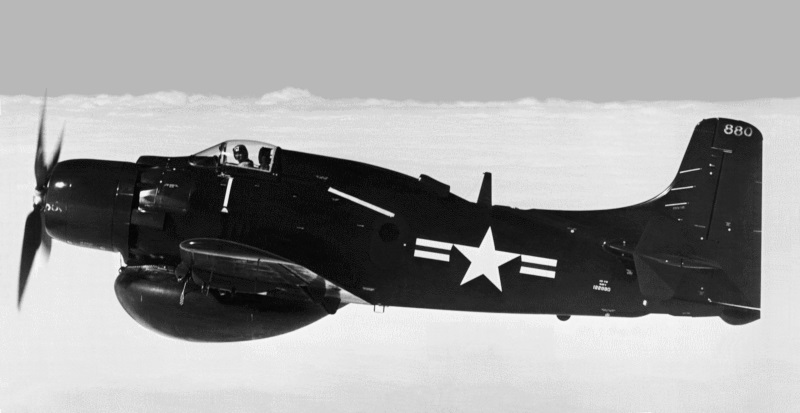
* Further improvements in the Skyraider led to the "AD-4", which was built in larger numbers than any other Skyraider variant. The most significant improvement was fit of the R-3350-26WA engine, providing 2,015 kW (2,700 HP). In addition, the cockpit was revised and a new wider windscreen with tougher armor glass was installed; the pitot tube on the tailfin that had been deleted from the AD-3 series was restored. Following conversion of an AD-3 to a production prototype, 372 AD-4s were built. From the 210th production example, another 20-millimeter cannon was fitted in each outer wing with 200 rounds per gun, providing a total of four cannon, with earlier production generally updated to the four-cannon configuration. AD-4 subvariants included:
There were a number of conversions of these aircraft:
* Navy and Marine pilots converting to the Skyraider found it a pilot's aircraft -- "unfunny", easy to fly, as well as powerful and rugged. It wasn't pretty, it was noisy and smoky and drank oil, but it was entirely masculine. Over a dozen Skyraider squadrons were in service when the Korean War broke out on 25 June 1950; within a week, Navy Skyraiders were in combat, initially performing strikes off the carrier USS VALLEY FORGE. Marine Skyraiders didn't get into the fight until October 1951. The Able Dog proved very useful in the conflict, being capable of delivering 900-kilogram (2,000-pound) bombs with dive-bomber precision. It could take extreme punishment, with tales of Skyraiders with a big hole blasted in them getting back home.

Night-attack Skyraiders also proved their worth, engaging targets by the light of airdropped flares. Some AD-4N machines were modified as drone controllers, direction Grumman F6F Hellcats converted to "robot bombs" for attacks on "hard targets". The AEW and ECM versions of the AD provided valuable service as well.
* As the Korean War dragged on to its inconclusive end, Douglas continued to refine the Skyraider. The "AD-5" was a particularly significant update, with a fuselage stretch, a wider fuselage to accommodate side-by-side seating, and a bigger tailplane with a wider rudder. Two or four crew could be accommodated, depending on configuration; the canopy over the two front-seaters slid back to open, the canopy over the two back-seaters (if present) hinged up in halves along the centerline of the canopy. In some cases, the rear canopy panels were tinted blue. The seat for the copilot on the right front was set back of the seat for the pilot on the left front; the rear seats were aligned.
___________________________________________________________________
DOUGLAS AD-5 SKYRAIDER:
___________________________________________________________________
wingspan:
15.24 meters (50 feet)
wing area:
37.21 sq_meters (400.33 sq_feet)
length:
12.2 meters (40 feet)
height:
4.24 meters (13 feet 11 inches)
empty weight:
5,575 kilograms (12,295 pounds)
normal loaded weight:
7,705 kilograms (17,000 pounds)
MTO weight:
11,340 kilograms (25,000 pounds)
max speed at altitude:
500 KPH (310 MPH / 270 KT)
service ceiling:
7,925 meters (26,000 feet)
range:
1,935 kilometers (1,200 MI / 1,045 NMI)
___________________________________________________________________

The fuselage air brakes were deleted on the AD-5, with the ventral air brake lengthened. The AD-5 retained the armament of the AD-4, with four 20-millimeter cannon and 15 stores pylons -- though for whatever reasons, the inner wing pylons were modified to a "raked" configuration that extended forward of the wing, possibly to maintain center of gravity while carrying stores. The first AD-5, a modified AD-4, flew on 17 August 1951. 212 were built in all, along with a number of subvariants:
53 AD-5N machines were converted to "AD-5Q" ECM platforms; as with the AD-5W, the operators sat in the four-place canopy, with metal canopy coverings. In addition, the AD-5 series was designed from the outset as a multi-role machine, and could be adapted to different roles by the installation of mission kits:
The freighter kit even included a hoist that could be set up to load and unload cargo, with the host rigged for use to the tip of a folded wing with a brace added. It was also possible to install auxiliary fuel tanks in the rear cockpit. Sources mention interest in using the Spad as an inflight tanker using a buddy refueling pod, but apparently it was rarely if ever used in that role -- likely because it was just too slow for refueling jet "fast movers". The AD-5 was sometimes referred to as the "12-in-1" Skyraider because of its configurability. No AD-5 saw any real action in the Korean War; production priority was on the AD-4 series, which led to delays in the introduction of the AD-5.
* The AD-5 was the only Skyraider with the four-seat cockpit. The "AD-6" retained the single-seat configuration of the AD-4; it was in fact similar to the AD-4B, with a slightly improved R-3350-26WD engine providing 2,015 kW (2,700 HP), providing the same power as the -26WA engine. It was apparently oriented towards the close-support mission. The changes included modernized and simplified avionics; modernized bomb racks and long ventral airbrake as per the AD-5; airframe reinforcement; and armor added to the sides and bottom of the cockpit.
Sources claim that the canopy could be jettisoned, though it seems odd that wouldn't have been a feature in earlier variants, it not being a new idea, nor hard to implement. Later on in their careers, in the mid-1960s the AD-6 was fitted with a pilot escape scheme, known as the "Yankee" system, apparently for its method of operation. It wasn't an ejection seat; it was a rocket attached to the pilot's harness that was fired to yank him out of the cockpit. It apparently worked pretty well, and was no doubt preferable to trying to climb out of the cockpit and hope to jump clear of the tail -- but it is unclear how much confidence pilots had in this contraption. In any case, 713 AD-6 Skyraiders were built; there were no subvariants.

* The last production variant of the Skyraider was the "AD-7", which was almost identical to the AD-6 but featured stronger and slightly longer wings, plus reinforced landing gear. 72 were built, with the last rolled out in February 1957; again, there were no subvariants. That was the end of Skyraider production, with 3,180 built in all, including prototypes. When the US military adopted the multi-service designation scheme in September 1962, surviving Skyraiders were redesignated as follows:
* The Skyraider remained an important Navy / Marine asset following the Korean War, with colors changing in 1957 from the old overall blue to the new white belly / gull gray top standard Navy colors. The Skyraider began to be slowly replaced in service in 1956 by the A4D Skyhawk, but the Spad remained in service for over a decade more -- in fact, it put in considerable overtime during the Vietnam War.
US Navy Skyraiders were among the first aircraft to perform strikes on North Vietnam with the escalation of the conflict in 1964. For four years, the Spad would prove its value in close-support missions over South Vietnam and incursions into North Vietnam. Ground-pounders really liked the Skyraider, since it had a heavy bombload, was capable of very accurate strikes, and could remain over the battle area for far longer than a jet "fast mover".
The Spad proved particularly well suited to the helicopter escort mission, accompanying flights of troop helicopters to provide firepower against threats in the landing zone, and also providing security to help protect air rescue helicopters retrieving downed aircrews. Typical ordnance for such missions included cluster bombs, mine dispensers, unguided rocket pods -- sometimes with rockets fitted with smoke warheads to mark ground targets -- and SUU-11 7.62-millimeter Gatling Minigun pods, better for antipersonnel work than the Spad's own powerful and relatively slow-firing 20-millimeter cannon.
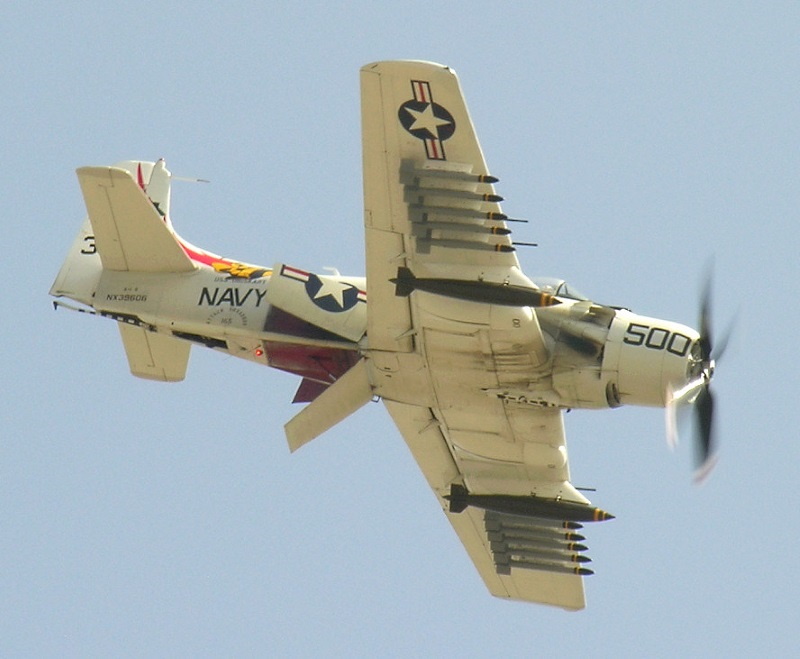
Navy Skyraiders even scored a few air-to-air "kills" against incautious North Vietnamese pilots. On 20 June 1965, Lieutenants Charles Hartman and Clinton Johnson, each flying an A-1H, were credited with shooting down a MiG-17 with cannon fire; their flight had been attacked by MiGs, with the Spads then dumping their stores and going into a circle, where each could protect the tail of the other. A MiG-17 tried to break into the circle, and was promptly blown out of the sky. On 9 October 1966 Lieutenant JG William T. Patton, also flying an A-1H, shot down a MiG-17, again with cannon fire. However, as the war dragged on adversary air defenses steadily improved, and the elderly Spad became increasingly vulnerable -- despite attempts to improve its survivability, for example by carriage of an AN/ALQ-81 jammer pod on the centerline pylon. The last Navy Spad missions were flown at the end of 1968, with most of the aircraft being placed in storage on retirement. The last Navy / Marine Skyraiders were out of service by 1972.
The US Air Force also operated the Skyraider over Vietnam. In 1962, a Special Warfare Center was established at Eglin Air Force Base in Florida to evaluate various aircraft that might be useful in the counter-insurgency role. Aircraft that were evaluated and went into combat include the Douglas B-26 Invader, the North American T-28, and the Spad. The evaluation of the Skyraider convinced the Air Force of the particular merit of the type, and so the USAF obtained 150 hand-me-down A-1E Skyraiders from the Navy. Air Force Skyraiders were in combat by 1964. They were modified for dual controls, and at least initially flow "cooperatively", with a South Vietnamese pilot in principle backed up by a USAF pilot -- though the South Vietnamese pilot was often just "along for the ride".

The USAF later obtained hand-me-down A-1H machines. Typical colors of these machines were light gray on the belly, with a disruptive pattern of light brown and green on top; some photos show machines painted black on the belly, presumably for night action. Air Force Spads were heavily used in the "Sandy" role, named for the radio callsign, protecting rescue helicopters; in fact, Air Force Spads remained in combat in Vietnam up to the final withdrawal of US forces in 1972.
BACK_TO_TOP* Foreign use of the Skyraider was modest -- the US did not push it on the export market, since there was such high demand for the machine by the US Navy and Marines. The British Royal Navy Fleet Air Arm (FAA) was the first foreign operator, obtaining 50 AD-4W AEW machines under the Mutual Defense Assistance Program from 1951. As mentioned, the FAA Skyraiders were designated "Skyraider AEW.1". 20 of these machines were new-build, the rest were US Navy hand-me-downs. Some of the Skyraider AEW.1 machines participated in Operation MUSKETEER, the ill-fated Anglo-French-Israeli seizure of the Suez Canal in 1956.
The AEW.1s were effectively replaced by the Fairey Gannet AEW.3 in late 1960, though a few continued to fly in secondary roles into 1962. After their retirement, a dozen were sold to a Swedish company, Svensk Flygjianst AB, to be operated as target tow tugs under contract to the Flygvapnet, the Swedish air force. They were modified for the role by Scottish Aviation at Prestwick, with extraneous gear such as the radar / radome and tailhook removed, and the fuselage compartment set up as a tow winch operator's station, with bubble windows on each side to give the operator a view to the rear. These aircraft were painted bright yellow in service, lest pilots get confused and take on the tug instead of the target. Two more AEW.1 machines were later obtained as spares hulks. The Swedish Skyraider target tugs served into the early 1970s.
* In 1959, the Armee de l'Air (AA, the French Air Force) obtained 53 AD-4N and 40 AD-4NA machines, a total of 93, all hand-me-downs from USN service obtained from the US Military Assistance Program -- some sources claim 113 machines were passed on. They were refurbished by SFERNA in France, with the AN-4N aircraft converted to AD-4NA standard. They were obtained to help combat the insurgency in Algeria. The French Skyraiders lingered in service into the early 1970s, often being used in "brushfire wars" in Africa.
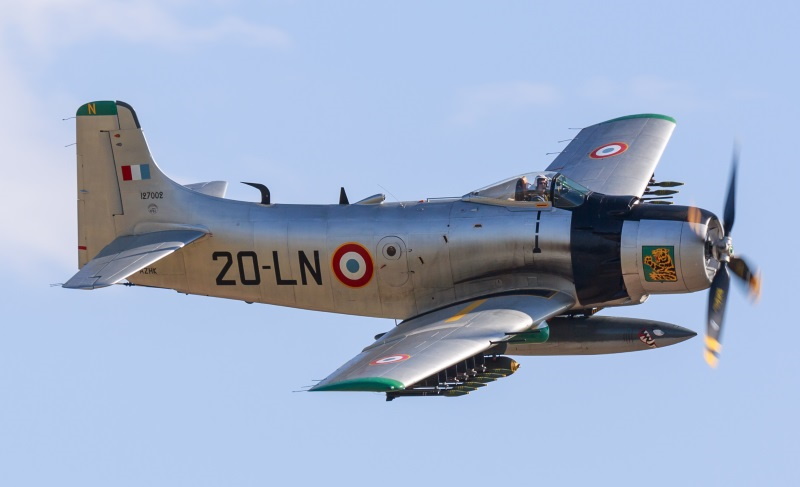
The French passed on ten Skyraiders to Cambodia in 1965, with five more provided later. The Cambodian Skyraiders saw increasing combat as the country was gradually drawn into the war in Vietnam, ultimately leading to the takeover of Cambodia by the savage Khmer Rouge regime in 1975. The fate of Cambodian Skyraiders is unclear.
South Vietnam operated hand-me-down US Skyraiders from 1960 to the fall of the country to the North Vietnamese in 1975. Initial deliveries were of 12 AD-6 (A-1H) single-seaters in 1960. The South Vietnamese pilots were trained in the USA, one of the more flamboyant of them being Nguyen Cao Ky, a hotshot flyboy who was later Premier of South Vietnam. Later on in the war, two-seat A-1E / A-1G machines were introduced, though some South Vietnamese squadrons eventually updated to the Cessna A-37 "Super Tweet" and the Northrop F-5. Some South Vietnamese Skyraiders escaped to Thailand when South Vietnam fell in 1975; others were captured intact by the North Vietnamese -- but other than being flight evaluated by the Soviets, these aircraft saw no further service.
* The following list summarizes Skyraider variants and production:
Total production was 3,180 Skyraiders.
BACK_TO_TOP* The "A2D-1 Skyshark", mentioned above, grew out of a US Navy request to Douglas in the spring of 1945 to investigate a turboprop-powered attack aircraft. The Navy was uncertain that the new jet technology was really appropriate for carrier operations; turboprop technology seemed to offer a reasonable compromise between advanced technology and operational prudence.
Douglas considered several possible designs, with an XBT2D-1 to be converted to turboprop power as a demonstrator, but problems with engine development meant that demonstrator never happened. That was a hint of problems to come. Early in the jet age, there was a certain naivete about turboprop power. Since aviation had been dominated by propellers to that time, it appeared to many that turboprop propulsion was the logical next step in aircraft design, just replacing the piston engine with a turbine engine. It certainly seemed a less radical step than simply dispensing with the propeller completely and relying on exhaust thrust alone for propulsion.
That line of thinking turned out to be exactly wrong, for the simple reason that, at least as far as early aircraft turbine engines were concerned, turboprops were actually well more complicated and troublesome than turbojet engines; turboprop development would lag turbojet development by about a decade. Besides, it was hard to imagine early in the jet age just how dramatic the improvement in performance pure jet propulsion would eventually provide, reaching speeds that no turboprop engine could touch. In any case, after sorting through options for a turboprop powerplant, the Navy selected the Allison Division of General Motors to develop what would later be called a "twin-pac" engine -- two turbine engines rigged in parallel, driving a common propeller system through a single gearbox. The engine was given the designation of "XT40-A".
By the spring of 1947, Navy officials had refined their requirements for a turboprop attack aircraft, adding in a specification that it be capable of air-to-air combat, with Douglas responding with an AD Skyraider fitted with the XT40 engine. In September 1947, the Navy ordered two prototypes of the "XA2D-1".
However, the original idea of simply mating a turboprop to the Skyraider proved unrealistic. While the XA2D-1 retained the general configuration of the Skyraider, it ended up being almost completely redesigned. The wing profile was visibly different, with forward root extensions; the cockpit was pressurized; and the canopy was redesigned, with oval side panels instead of the all-round vision bubble canopy of the AD. It was powered by an Allison XT40-A-2 engine, driving a contra-rotating prop, with three blades on each of the two prop sections; one of the engines could be shut down in flight to conserve fuel. Armament was to be along the lines of the Skyraider, with four 20-millimeter cannon in the wings and munitions carried on pylons -- one under the centerline, one under each inner wing, four on each outer wing, for a total of 11 pylons.
The first XA2D-1 performed its initial flight on 26 March 1950, with the test pilot reported severe engine vibration. On the basis of the belief that the problems could be worked out, production orders were placed. Unfortunately, things just kept going from bad to worse, with more problems cropping up; the program was dealt a particularly severe blow on 19 December 1950 when the first prototype crashed, killing the pilot, Lieutenant Commander Hugh Wood. Investigation suggested the cause of the crash was a failure of one of the turbine units during a dive.
The second XA2D-1 didn't take to the air until 3 April 1952. Matters didn't improve; despite extensive changes in the course of the flight test program, Douglas still couldn't get the machine to fly right. The AD-4 seemed to be well good enough for the war in Korea, and the Navy was feeling more confident about pure jet propulsion; in mid-1952, the Skyshark program was canceled, though ten production machines were to be completed -- it seems just to see if the aircraft could be fixed.
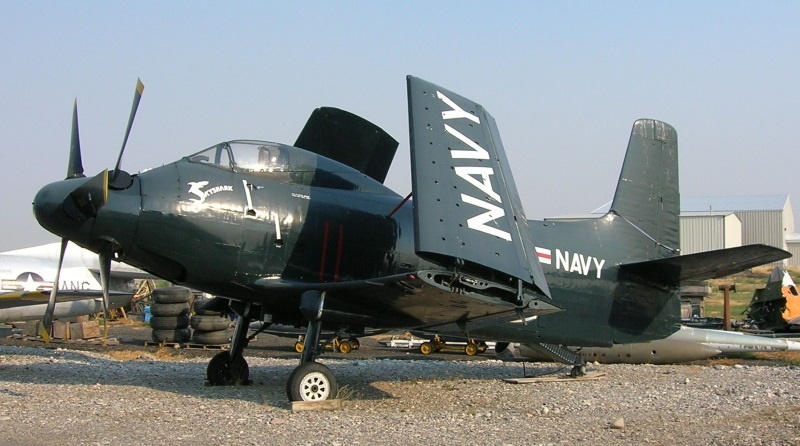
The first production A2D-1 performed its initial flight on 10 June 1953, with four more Skysharks delivered to the end of the year. Problems continued, with one of the A2D-1s crashing near Los Angeles on 5 August 1954. Some sources claim the rest of the batch of ten were completed, but they never actually flew. One of these machines still survives today, as a museum display.
BACK_TO_TOP* I long found the Spad an interesting machine, but I never saw any of them around when I was a lad; thanks to the airshow circuit, I finally did get to see them in action of sorts. I was also very startled to find the surviving Skyshark being restored in Idaho Falls, where I got a shot of it.
* Sources include:
An online writeup by aviation enthusiast Joe Baugher was also used as a source.
* Illustrations details:
* Revision history:
v1.0.0 / 01 aug 10 v1.0.1 / 01 jul 12 / Review & polish. v1.0.2 / 01 jun 14 / Review & polish. v1.0.3 / 01 may 16 / Review & polish. v1.0.4 / 01 apr 18 / Review & polish. v1.0.5 / 01 nov 19 / Illustrations update. v1.0.6 / 01 oct 21 / Illustrations update. v1.0.7 / 01 sep 23 / Review & polish. v1.0.8 / 01 oct 25 / Review & polish. (!)BACK_TO_TOP
